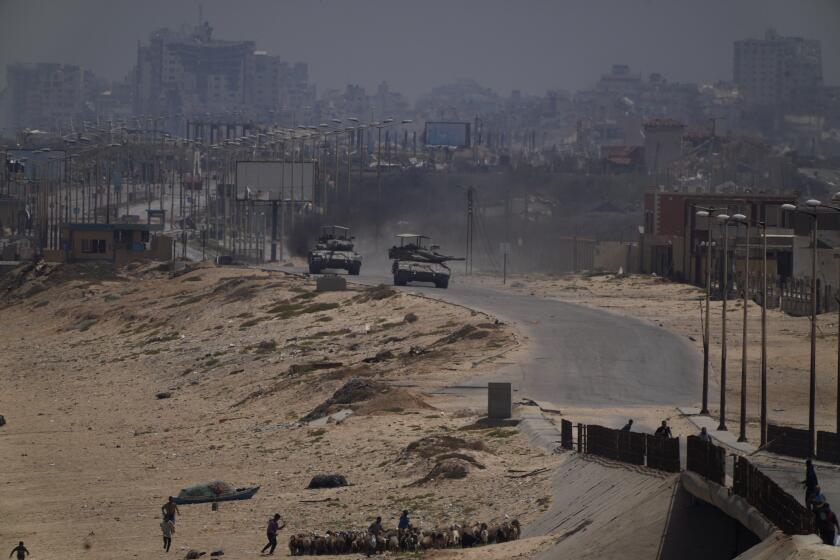Press Tours Nuclear Site, Told ‘It’s Safe’ : Rockwell Seeks to Soothe Fears Over Radiation-Contaminated Lab
At Rockwell International’s Santa Susana Field Laboratory west of Chatsworth, some of the nation’s most sophisticated scientific research takes place in a ranch-like setting where workers use Geiger counters to measure radiation and sticks to scare off rattlesnakes.
Monday, in response to a controversy over the site’s environmental safety, reporters carrying radiation measurement instruments were given a three-hour tour of a portion of the 2,668-acre complex where nuclear research was conducted for nearly 40 years.
Radioactive and chemical contamination of the area was described in a report released last month by the U.S. Department of Energy, which contracted with Rockwell’s Rocketdyne division for nuclear work.
The fenced facility, atop a hill overlooking the San Fernando and Simi valleys, is a mosaic of sandstone outcroppings and oak trees, crisscrossed by narrow roads that link clusters of corrugated metal buildings. Huge steel scaffolds used to test rocket engines and an occasional smokestack looming above the grassy hills are the only signs of scientific activity.
Company officials beat the brush with sticks to frighten rattlesnakes in remote areas.
‘Nothing to Hide’
Rocketdyne spokesman Paul Sewell said the firm offered the tour because “we have nothing to hide and what we have to show supports what we’ve said all along--it’s safe up here.”
The DOE report stated that while the pollution poses no immediate threat to nearby residents, more environmental tests are necessary to determine the extent of contamination.
It was impossible to draw conclusions about pollution at the site from the brief tour.
In some spots near buildings that housed nuclear waste before it was trucked to out-of-state disposal sites, radiation meters showed readings three times the level of naturally occurring background radiation. This level--only slightly higher than the normal radiation from the sun’s rays in high-altitude cities such as Denver--is not considered dangerous to health.
Between 1947 and 1986, nuclear research was conducted on a 290-acre portion of the site, said R. J. Tuttle, Rocketdyne’s manager of health and safety.
The company operated 16 nuclear reactors at the site, most of which have been entirely removed, he said.
That process, which often involves replacing contaminated floors and other features of the reactor buildings, has transformed one building into an area used to test firefighting methods, he said. It has also been used without harm by sparrows as a nesting place and by film crews as a set for television shows, such as “The Six Million Dollar Man,” Tuttle said.
Nuclear Work Ended
No nuclear work is now being done at the site, although Rocketdyne plans to bid on contracts with DOE to recycle spent nuclear fuel rods, Tuttle said.
The building where fuel rods were recycled until 1986 is being stripped of residual radiation, he said. If Rockwell is awarded contracts in the future, technicians, peering through lime-tinted lead glass, will once again use remote-control devices called “master-slave manipulators” to strip fuel rods of their metal coating, Tuttle said. A black-and-tan striped smokestack equipped with a special filter will clean the air in the building before it is released, and workers will be tested with Geiger counters for possible exposure to radioactivity, he said.
The DOE report said that in one area of the facility, called the sodium burn pit, soil tests revealed levels of radioactive cesium as high as 700 picocuries per gram of soil--about 30 times higher than normal background radiation--a level that poses no immediate hazard. The 15-foot-deep pit, which Rocketdyne covered last month with concrete to prevent animals from falling in, was used to rinse highly flammable materials, such as sodium, with water, Tuttle said. The company is unsure where the radioactive material came from, but some waste may have been dumped there by accident, Tuttle said.
Times Staff Writer Myron Levin contributed to this story.
More to Read
Start your day right
Sign up for Essential California for news, features and recommendations from the L.A. Times and beyond in your inbox six days a week.
You may occasionally receive promotional content from the Los Angeles Times.






